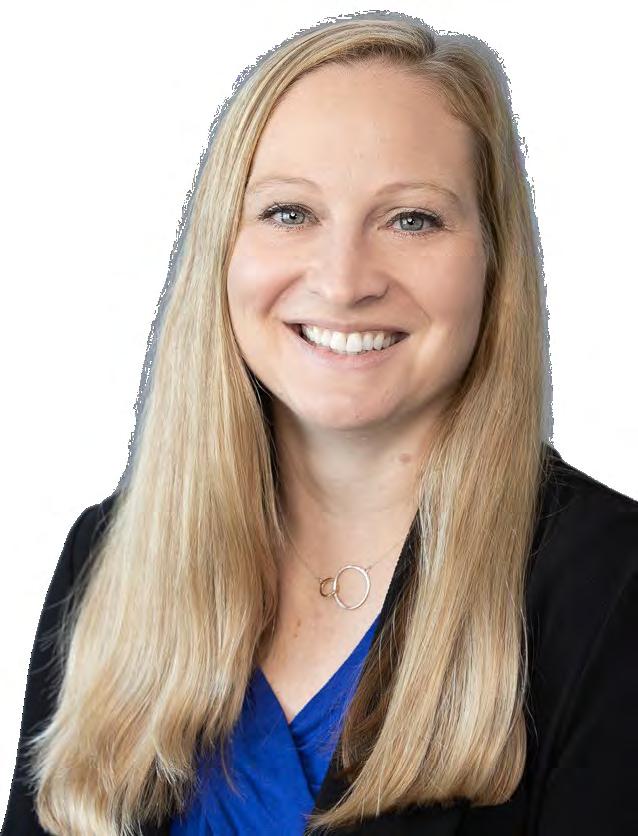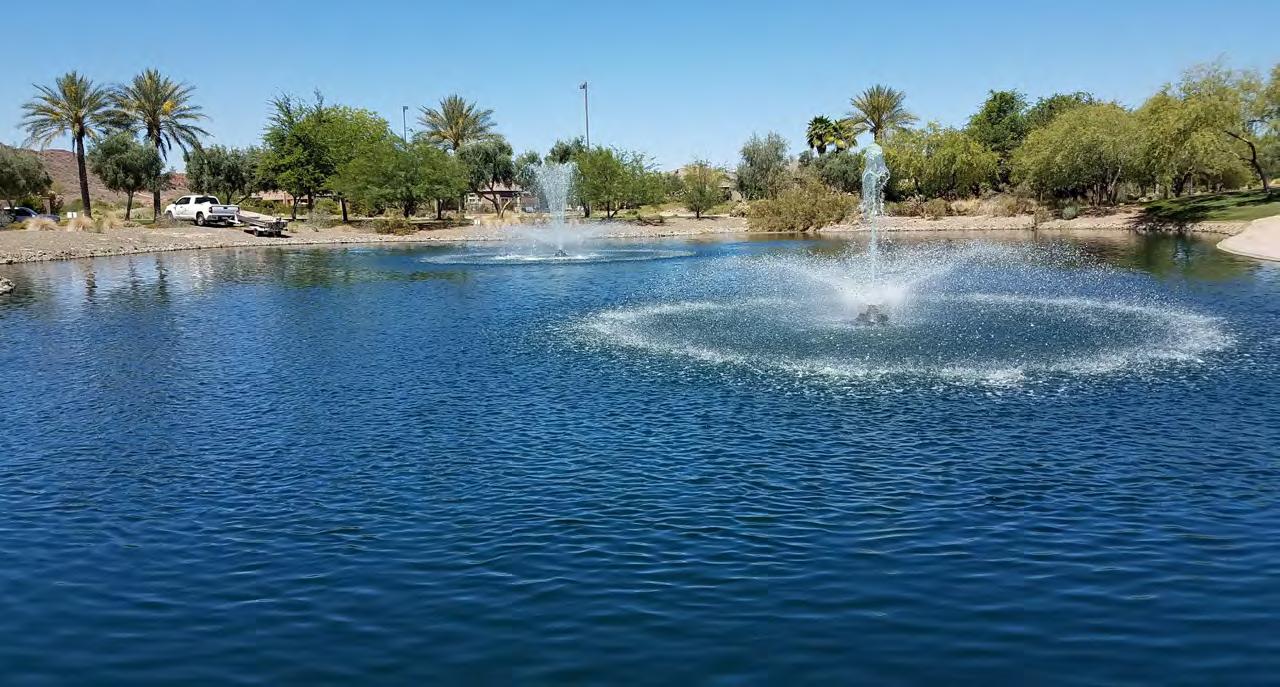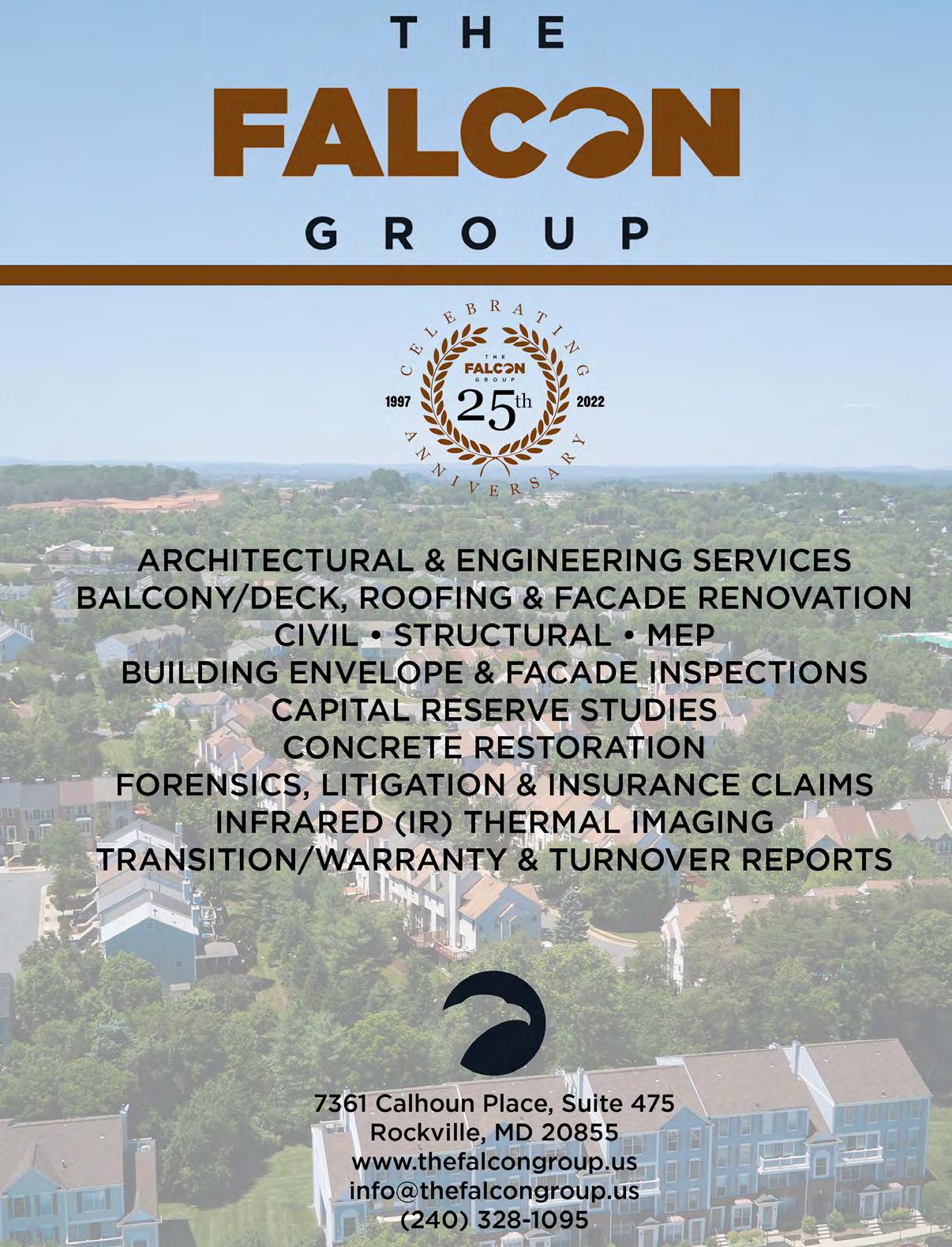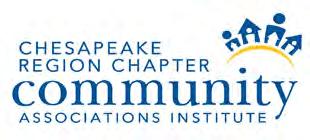BEA C ON THE
Winter / Spring 2023
Look inside for our 2023 events, informative articles & more!


Look inside for our 2023 events, informative articles & more!

President Rebecca Clemson-Petrik, CMCA, AMS, PCAM
FirstService Residential
President-Elect James Anderson, PE
Vice-President
Becht Engineering BT, Inc
Gail Windisch, CMCA, AMS, PCAM
Tidewater Property Management, Inc. AAMC
Secretary Noni Roan, CMCA
Treasurer Vicki Eaton, CMCA, AMS, LSM, PCAM
Community Association Services, Inc., AAMC DIRECTORS
Hillary Collins, Esq, Rees Broome, PC
Cynthia McKoin, Potomac Ridge Condominium, Inc.
Steve Randol, Piney Orchard Community Association
Gary Saylor, Atlantic Maintenance Group

Social Dani Bressler, Chair Toepfer Construction Co., Inc.
Carrie Ehart, Vice-Chair
Raine & Son, LLC
DelMarva Chad Toms, Chair Whiteford, Taylor & Preston, LLP
Lisa Meck, CMCA, AMS, Vice-Chair
Carl M. Freeman Companies
Education
Christa Brady, AMS, PCAM, Chair
USI Insurance Services
Michelle Jones, CMCA, AMS, PCAM, Vice-Chair
General Manager, Lake Linganore Association
EXPO
Ellen Throop, Chair
Davis, Agnor, Rapaport & Skalny, LLC
Joanne Frallicciardi, CMCA, AMS, Vice-Chair
Community Association Management, LLC, AAMC
Chesapeake Region Chapter of CAI
Valerie Lykins, Executive Director
Angela Marsh, Marketing and Events Manager
Christina Killian, Office Administrator PO Box 6838, Columbia, MD 21045
Office Line: 410-348-1534
Membership Line: 410-505-8746
Office Email: contact@caimdches.org
Membership Email: membership@caimdches.org www.caimdches.org
This publication attempts to provide CAI’s membership with information on community association issues. Authors are responsible for developing the logic of their expressed opinions and for the authenticity of all presented facts in articles. CAI does not necessarily endorse or approve statements of fact or opinion made in these pages and assumes no responsibility for those statements. This publication is issued with the understanding that the publisher is not engaged in rendering legal, accounting or other professional services. If legal advice or other expert assistance is required, the services of a competent professional should be sought. Permission to reprint articles in Beacon may be granted only after receiving prior written approval from the CED of CRC/CAI.
Golf
Chase Hudson, Chair
Sahouri Insurance
T.J. Socks, Vice-Chair
Becht Engineering BT
Legislative Cynthia Hitt Kent, Chair, Chair
Law Office of Cynthia Hitt Kent, LLC
Karen Fooks, CMCA, AMS, Vice-Chair
Community Management Corporation/Associa
Membership Jennifer Melson, CMCA, AMS, Chair
Premier Property Management
Beth Bencivenni, Vice-Chair
SecureCore
Magazine Michelle Baldry, Chair Reserve Advisors
Don Plank, PCAM, Vice-Chair
National Cooperative Bank
Communication Alicia Menefee, CMCA, AMS, Chair
FirstService Residential
Vince Scarfo, CMCA, Vice-Chair
Clear: Restoration and PreDisaster Consulting
I am honored, thrilled and (to be honest) slightly terrified to be your 2023 Chapter President. This year has already shown us that change is enviable and something that at times we cannot control. Heraclitus said “There is nothing permanent except change.” With the hard work of committees, the Board and our staff we will continue to see change in 2023; bringing new venues, new events and new ideas to our membership.
Over the past two years I’ve been fortunate to witness two amazing leaders set their goals, and watch both accomplish those goals. In 2021 Gail Windisch wanted to “Grow Together” by surpassing 1200 members. Last year Susan Rapaport wanted to take the chapter to the “Next Level”. Today our chapter has 1252 members, which pushes us over the edge of being a Large Chapter to being an Extra Large Chapter. Thirteen years ago when I first registered for the Chesapeake Chapter there were 605 members. Needless to say over those thirteen years we have absolutely grown together. Many of you have been a part of that journey and I’m so grateful for each and every one of you. Many of you have been a part of the growth that we needed to become who we are today, an Extra Large Chapter. My hope is that all of our members can share in my excitement as we step into 2023 with “No Limits” to what we will be in the future.
I hope you are able to join us sometime in 2023 to share in the education, networking, advocacy and excitement that we have planned for this year!
Yours truly,

It is with great shock and sadness to inform you that Susan Rapaport with Davis, Agnor, Rapaport & Skalny, suddenly passed away on Tuesday, January 31st from natural causes. Susan had just begun her second term on the Board of Directors currently serving as the Secretary and was the immediate past President. Susan was one of the founding members of the Maryland LAC, spending the last 10+ years advocating for Associations on both a state and national level. She also sat on various committees both as an active member and/or Board Liaison. Her presence, knowledge and humor will be missed by all those that had the opportunity to work with her

Mr. Jason Abela Canal Corkran Homeowners Association
Mr. Jack Anderson Lake Linganore Association, Inc.
Brandon Benitez Clagett Enterprises, Inc.
Mr. Ronald Bjorkland Greenbrook Estates Homeowners Association
Mr. Arthur Blume Council of Unit Owners of Whiskey Bottom Condominium - South, Inc
Mr. Christian Bowers Gap View Village Homeowners Association, Inc.
Ms. Leila Carp Watermark Place Condominium
Ms. Geraldine Centeno Council of Unit Owners of Whiskey Bottom Condominium - South, Inc

Mr. John Chenoweth Rosslare Ridge Condominium, Inc
Mr. Michael Daniel Property Management, Inc.
Ms. Debbie Denson
Mallard Landing Council of Unit Owners
Ms. Jennifer Dieste Paradise Properties, Inc.
Mr. Austin Edwards
Addresses of Distinction
Kadi Englehart Clagett Enterprises, Inc.
Mr. Richard Farr
Ocean Pines Association, Inc.
Mr. Gary George
The Laurels Condominium Council, Inc
Mrs. Ashleigh Givens
Ms. Debbie Horowitz
Council of Unit Owners of Whiskey Bottom Condominium - South, Inc
Ms. Lauron Huntley
Council of Unit Owners of Whiskey Bottom Condominium - South, Inc
Mr. Steve Jacobs
Ocean Pines Association, Inc.
Mr. William James Greenbrook Estates Homeowners Association
Mrs. Arnetta Jones WPM Real Estate Management
Ms. Carolyn Jones Greenbrook Estates Homeowners Association
Ms. Barbara Keenan Solitude on White Creek Homeowners Association
Ms. Natasha Killens Stoneridge Condominium
Dr. Stuart Lakernick Ocean Pines Association, Inc.
John Majcher Bishops Landing HOA
Ms. Adena Mansback BankUnited
Ms. Maryssa McCallum
Professional Community Management
Mr. Christoph Mlinarchik
Gap View Village Homeowners Association, Inc.
Ms. Diane Nicholson
Heritage Harbour Community Association
Ms. Jill Pante Bishops Landing HOA
Mrs. Yvonne Payton
Council of Unit Owners of Whiskey Bottom Condominium - South, Inc
Mr. Darrell Piatt
Villages at Red Mill Pond
Mr. Thomas Piatti
Ocean Pines Association, Inc.
Mr. Edward Putens
Greenbrook Estates Homeowners Association
Ms. Monica Rakowski
Ocean Pines Association, Inc.
Mr. Marc Russell
Villages at Red Mill Pond
Mr. Johannes Sayre
Villages at Red Mill Pond
Ms. Joanne Settel
Watermark Place Condominium
Mr. Dan Shuler
Legum & Norman
Ms. Ruth Steelman
Community Association Services, Inc.
Ms. Linda Summers
Forest Landing Community Association, Inc.
Mr. Anthony Swetz
Carroll Vista Community Association
Mr. Andrew Taliaferro Concrete Jack
Mr. Robert Thomas Greenbrook Estates Homeowners Association
Mr. John Viola
Ocean Pines Association, Inc.
Mr. Stephan Ward-Smith AquaGuard, LLC
Ms. Christy Weer
English Towers Condominium Association
Ms. Shannon Wingfield
FirstService Residential
Ms. Michelle Wright Capital One
Ms. Annemiek Young
Ms. Jody Nightingale OSG
Chester River Landing Council of Unit Owners
“I have recently joined the Magazine Committee and I am looking forward to my first meeting. I hope to improve my communication skills and to learn from others in my field.”
Dawn Lewis, Community Manager, Property Management People















A few months ago I made a weekend visit to Baltimore and stumbled across the Rawlings Conservatory in Druid Hill Park, Baltimore. Now known formally as The Howard Peters Rawlings Conservatory and Botanic Gardens, the conservatory first opened in 1888 and is the second oldest steel framed and glass building still in use in the U.S. While the original structure included the magnificent Palm House and Orchid Room, the facility has since been expanded to include three greenhouses as well as display pavilions and outdoor gardens. The Mediterranean, Tropical and Desert houses contain a wide array of plants from around the world. However, my personal favorite was the Orchid Room which housed a dazzling display of orchids including one that smelled like chocolate. Delicious!
No visit is complete without spending some time chatting with the front desk attendant. We were lucky enough to have a long-time volunteer explain the history and give recommendations on what to look for while walking through the exhibits. It’s definitely worth the conversation.
Hopefully you’ll take some time to explore this magnificent structure located right in our backyard. I think you’ll find it to be a rewarding time! For hours and directions, check out https://rawlingsconservatory.org/ hours-and-directions/.
Written by: Don Plank, National Cooperative Bank www.ncbassociationbanking.coop | 703-302-1928 | dplank@ncb.coop
“
opportunitiesThecontinuededucationalaretheprimaryreasonforbeingamemberofCAI. It'snotthe recreationofthewheelbutthesmallnuggets ofinformationthatIlookforthatImaynot haveotherwisethoughtaboutorthedifferent perspectivesomeoneelsebringstothe experience.”
ChristyStevens,Vice-President, WallceH.Campbell&Co.


Atlantic Maintenance Group
Becht Engineering BT, Inc.
ETC, Inc
Hann & Hann Construction Services
Kris Konstruction Roofing Professionals
Mid Atlantic Asphalt, Inc.
MillerDodson Associates, Inc.
Minkoff Company
North Arundel Contracting, Inc.
Pinnacle Financial Partners
Rees Broome, PC
RoofPRO, LLC
Sahouri Insurance
The Falcon Group Engineers, Architects & Reserve Specialists
Tidewater Property Management, Inc., AAMC

Davis, Agnor, Rapaport & Skalny
EJF Real Estate Services
FirstService Residential
Nagle & Zaller, P.C.
Palmer Brothers Painting & General Contracting
SI Restoration
Simmerer Insurance LLC
Unlimited Restoration, Inc.
Whiteford, Taylor & Preston
WPM Real Estate Management

Connie Phillips Insurance
Truist Association Services
Pacific Premier Bank Community Association Banking
Condominium Venture, Inc.
Diversity, Equity, and Inclusion (DEI), has become a strong focus in many companies, building a strong and happy workforce. It would stand to reason then, that to build a strong and happy community, including DEI tools in the daily management of these communities would be beneficial. In 2019, the CAI Board of Trustees adopted a DEI Statement, “Community Associations Institute is committed to making diversity, equity, and inclusion a core aspect in our membership, on our staffs, and within the community association housing model at large. (To read the rest of this statement, please visit, Diversity, Equity, and Inclusion (DEI) Statement (caionline.org)”. These are important values that all communities should strive for; the concept of promoting and celebrating diversity within a community, while also ensuring that all individuals are treated with fairness and respect. This includes recognizing and addressing any systemic barriers or inequalities that may prevent certain individuals or groups from fully participating and thriving in their community
Unfortunately, the rise in discrimination cases within community associations has made incorporating DEI challenging. In many communities, there are still significant disparities and injustices that need to be addressed to create a truly inclusive and equitable environment. For example, some individuals may face discrimination or unequal treatment due to their race, gender, sexual orientation, religion, or other identity. This can lead to feelings of exclusion and marginalization, which can have a negative impact on individuals and the community.
In 2020, The Foundation for Community Association Research investigated the extent of discrimination claims in community associations to determine if communities with robust communications and active social events calendars would have fewer
problems. The guide for creating harmony in communities was created based on that research. CAIDiverseCommunitiesGuide041521.pdf (caionline. org). The findings of this research determined that CAI should create training and education that covers several aspects of diversity and discrimination: formal procedures for handling the issues; events and communication; state and federal laws; relevant court cases; and managing complaints between residents and those directed at the board. The full report is available on CAI’s website at, https://foundation. caionline.org/wp-content/uploads/2021/03/ FCARCreatingHarmonyReport032521.pdf. By educating ourselves and others about the issues and challenges that some individuals may face, we can gain a better understanding of the ways in which we can work together to create a more inclusive and equitable community. This can include learning about the history and experiences of marginalized communities and participating in discussions and events that promote DEI.
As a property manager or management company, incorporating the lessons learned from the Foundation’s research is an important factor in creating harmony within your communities. CAI has several resources available to aid in integrating this information into daily management. The following link will take you to these resources.

https://www.caionline.org/HomeownerLeaders/ Pages/Diverse%20Communities.aspx
Written by: Dani Bressler, CAS, EBP, Toepfer Construction Co., Inc dbressler@toepferco.com & Elisabeth Kirk, TRC Engineering, EBP ekirk@trc-engineering.com


It is an unfortunate reality that almost every Association has owners that do not pay assessments in a timely manner or sometimes not at all. The delinquent balances are reflected as an assessments receivable balance on the Association’s financial statements. The Association and management should periodically determine if an estimate to reduce the assessments receivable should be recorded in the Association’s financial statements for the delinquent balances that may not be collected. This estimate account is called an allowance for doubtful assessments. The allowance account is a negative balance (a contra-asset account) that reduces the delinquent owner balances to a realizable (collectible) level. This tells the readers of the financial statements that there is a possibility that not all the delinquent balances will be collected. The delinquent owner balances are not actually written off and will continue to be reflected on the monthly delinquency report. Using an allowance account, the Association will recognize bad debt expense on a consistent basis over time as the owner becomes delinquent rather than in a lump sum when an owner’s balance is written off. This will also give the Association a more realistic view of the Association’s financial position. If the Association subsequently collects a delinquent owner’s balance that was included in the allowance, then the Association would recognize bad debt recovery (income) in the year collected. If the Association subsequently writes-off a delinquent owner’s balance that was in the allowance, then the Association would reduce the allowance and would not recognize any additional bad debt expense.
Our firm uses the following guidelines in estimating the allowance for doubtful assessments; however, the Association may develop its own guidelines based on the collection history of the Association:
Condominiums and Cooperatives - consider establishing an allowance for any delinquent balances that are more than six times the average monthly assessment.
Homeowners Associations - consider establishing an allowance for any delinquent balances that are more than 12 times the monthly assessment.
On the audited financial statements, the Assessments Receivable will be reflected as a net number. This means the Assessments Receivable - Net on the balance sheet is the total assessments receivable less any amounts established in the allowance for doubtful assessments. The notes that accompany the financial statements will reflect the components of the net receivable. The note might have a chart that looks like this:
If the Association has incurred bad debt expense on a consistent basis, it is recommended the Association include a bad debt expense line item within the annual budget to more accurately reflect the assessment income to be received from owners. The Association should look at which owners are not currently paying assessments to determine the budget for bad debt expense. The amount budgeted should not reflect amounts that are in the allowance, but rather what portion of the budgeted assessments will not be paid by owners.
In summary, every Association should review the delinquent owner balances monthly. The Association should develop a criteria for delinquent balances to be included in the allowance for doubtful assessments. If no delinquent balances meet the established criteria, an allowance for doubtful assessments may not be necessary. However, if delinquent balances meet this criteria, the allowance for doubtful assessments should be established. At least annually, the Association should adjust the allowance for doubtful assessments based on this criteria. Additionally, during the budget process, the Association should evaluate the need to include a bad debt expense line item in the budget.
Written by: Jennifer L. Murray, CPA Manager, Goldklang Group CPAs, P.C. jmurray@ggroupcpas.com





When it comes to the lakes and stormwater ponds in a homeowners association, residents expect them to be healthy, beautiful, and functional. At the same time, they may be averse to the use of herbicides and algaecides for the management of these water resources. Though the pesticides used to eliminate aquatic weeds, algae, and toxic cyanobacteria are very low-risk, well-studied, and registered with the Environmental Protection Agency (EPA), residents sometimes prefer a 100% natural approach. With this in mind, community managers may find themselves in an uncertain situation. How do they meet the expectations of residents while keeping management costs as low as possible?

Though community managers see their water resources as an asset, some may not believe they have the budget necessary to keep them in peak condition through natural means. Fortunately, this couldn’t be further from the truth. On paper, pesticides sometimes seem like the most affordable and fast-acting option to eliminate nuisance weeds and algae; but the key word there is “eliminate.” This approach only works to target undesirable growth that has already appeared. Natural management programs, on the other hand, work to prevent that growth from ever occurring. And while pesticide-reliant approaches only provide shortlived results – meaning treatment costs will continue to rise over time – natural maintenance efforts typically yield better results and slash treatment-related costs by nurturing a healthier, more resilient waterbody.
Communities that choose a natural approach have many tools available to them. When establishing a natural management program, aquatic experts can help stakeholders evaluate and understand their challenges, budget, and goals – and then create a tailored roadmap to achieve them. Though no two journeys are the same, almost all are driven by sciencebacked solutions and technologies:
Water quality testing kicks off this journey. By analyzing water samples in a scientific laboratory, professionals can identify pollutants, algal toxins, and potential imbalances below the surface. Once your aquatic expert has a more complete picture, they can implement the right solutions. When collected on a consistent basis, this data can also expose bigger trends and help experts detect water quality changes before problems occur.
Waterbodies that struggle with aquatic weed and algae issues tend to contain an excess level of nutrients like phosphorus. Nutrients are the building blocks of aquatic life, but a surplus can lead to an overabundance of growth. Under chemical-free management programs, professionals rely on naturallyoccurring products like aluminum sulfate or lanthanummodified clay to “lock up” these excess nutrients and prevent them from playing a role in the food chain.



Once nutrient levels in the waterbody are managed, it’s important to find the source. Grass clippings, yard waste, trash, animal droppings, lawn and garden fertilizers, and eroded sediment are all composed of nutrients, which inundate the water column when these organic materials are swept into lakes and ponds during rainstorms. Native flowering plants and tall grasses can be cultivated as a filtration buffer around the shoreline. Sometimes, nutrients are saturated in the bottom sediments. Hydro-raking or dredging can be used to physically remove this matter.
A well-managed shoreline is not only aestheticallypleasing, it’s essential to a healthy waterbody. In cases of severe degradation, a shoreline may need to be completely restored. Bioengineered restoration techniques are often the most impactful and longlasting. During the process, experts fill patented knit mesh materials with sediment (sometimes dredged from the bottom) and then shape and anchor it to the land. Once in place, bioengineered shorelines are strong and beautiful, yet virtually imperceptible.
Floating fountains are a staple of many HOA lakes to add movement and elegance to any waterbody. Fountains also have many water quality benefits such as circulation and oxygenation. A well-oxygenated waterbody is less hospitable to algae and weeds. Proper fountain sizing and equipment maintenance are crucial to reap these benefits. Professionals may also recommend pairing a fountain with a submersed aerator for top to bottom water quality improvements.
Proactive maintenance tools are excellent, but nothing can beat the impact of well-informed residents. We each play a role in the health of our surrounding waterbodies. Small actions like reducing the use of garden fertilizers, picking up trash, and properly disposing of pet waste can reinforce ongoing management efforts, help you maximize your freshwater maintenance budget, and bring people together for fun and relaxation around the water.
Sustainable management programs aren’t just about finding natural solutions; they’re about getting ahead of problems and the natural milestones of aging that we know will occur weeks, months, and years down the road. While herbicides and algaecides are helpful and sometimes necessary tools in lake and pond management, they should never be viewed as a lasting solution. Even if a 100% natural management plan is not feasible due to budget, goals, or existing conditions, implementing some or all of these ecofriendly management solutions can help reduce the reliance on aquatic herbicides and save you money in the long run. Interested in a more natural approach to achieving a beautiful lake? Your local aquatic expert will guide you on the path to success – so that worrying about pond weeds or erosion is one less thing on your to-do list.
Learn more about this topic at www.solitudelakemanagement.com/knowledge
- Written by: Trent Nelson Aquatic Specialist, SOLitude Lake Management info@solitudelake.com

I hear it all the time, the board gets a stack of paper reports but doesn’t look at them. The reason why? I suspect information overload and not knowing what to look for in each report. This can be overwhelming for a community board member who isn’t used to looking at financial reports. So what if you only needed a handful of reports to look at,that would make it simpler and take less time to get a picture of your association’s financial health? The following is Community Financials’ top 4 financial reports for HOAs and condo communities.

This aged delinquency report/aged owner balance report shows who is behind in their assessments. Different reports can also break out the delinquency by type of charge owed (assessment, late fees, etc). The board needs to review this at every board meeting to see what action needs to be taken at certain late dates (30, 60 days) like sending a demand letter or turning the account over to a collection attorney or agency. If you get behind in collections it can cause a problem with services at your community, and worse you may not be able to collect the entire past due amount depending on your state laws and how long it took you to commence legal action. Some states only guarantee collection of 9 months past due assessments and it takes a few months for the action to work itself through the courts. So if you are owed a year you may only get 9 months – ouch!

This is my favorite report to run for the association. The Income Statement is meant to inform association is compared to budget. It shows the current period actual expense, budgeted expense and any variance between the two. It also shows the same thing for the year to date. When you see a variance it is a warning flag to ask why and dig deeper. It can also allow you to make up any shortfall quickly so you don’t cripple your community’s cash flow and vendor payments. For example, if you are spending more on
snow removal than budgeted due to an extreme winter, you can do a special assessment right away to cover the shortfall while it is still cold and owners are more understanding.
A balance sheet is an important part of the financial package. It tells where the association stands with their asset, liability and reserves at a particular point in time.
There are three key accounts on a balance sheet that HOA officials should pay special attention to:
1. Cash in the Operating Checking Account – shows ability to meet current operating expenses.
2. Accounts Payable – shows how much is owed to vendors and ser


3. Capital Reserves – shows how much is available for major capita near and distant future.
The Bank Reconciliation report is used to “prove” that the cash assets shown on the association’s books and balance sheet agree with what the bank statement shows. The reconciliation takes into account outstanding checks that have not been processed by the bank as well as deposits of cash that have not been processed by the bank. There should not be any difference, it should be $0, but if there is a difference it is a flag for you to look into something further. This report is a great tool to ensure you are not a victim of embezzlement (for more on this see my Community Embezzlement Case Studies).

Bank statements are another tool to ensure you are not a victim of theft. Plus you can easily see how much money you have in the bank. Bank statements are easier to understand than the balance sheet since we’re all used to looking at them and they show the current amount of money in the bank account(s), recent deposits and withdrawals.

You don’t need a fancy report but you should have something that shows how much money you have set aside and the anticipated cost for replacements and larger capital projects. This report is far superior than looking at a capital/reserve bank account, which can be deceiving. You may think you have a lot of money saved but if you had a big roofing or paving project it could be wiped out with no funds for other projects.
As a volunteer board member you only have so much time to dedicate to operating your community. There are emergencies to deal with, vendors, projects and of course financial and administrative tasks. A large part of your responsibility is your fiduciary responsibility to the community. Overseeing that the community funds are safe and being spent properly is of high importance. To simplify this task we highly recommend you make sure to review Community Financials’ top 4 financial reports for HOAs and condo communities.
Written by: Russell Munz CEO & Founder of Community Financials833-CONDO-HOA (266-3646) x 700 russell@communityfinancials.com

In January 2022, Governor Larry Hogan announced the launch of the Maryland Homeowner Assistance Fund to provide aid to homeowners who have experienced financial hardship due to COVID-19. Approximately $248 million in federal American Rescue Plan relief will be administered by the Maryland Department of Housing and Community Development through the program, part of $2.5 billion in federal and state pandemic relief managed by the agency. Maryland was one of the first states in the nation to have its program plan approved by the U.S. Treasury and open its online application portal to homeowners whose ability to pay their mortgages and other housing related costs was impacted by the pandemic. This aid will help program eligible homeowners bring their delinquent mortgages and other eligible housing related costs current, while also ensuring their future monthly payments are affordable and sustainable.
Aid from Maryland Homeowner Assistance Fund can also be used to assist homeowners with other housing costs, including unpaid property taxes, condo and homeowner association fees, mobile home loan payments, land lease and ground rent delinquencies, and water and sewer fees. The fund also offers emergency home repairs through the WholeHome Grant. These grants help address immediate problems that may make the home unsafe or uninhabitable, including mold remediation, asbestos and lead paint removal, lack of heat or air conditioning, electrical repairs; plumbing and septic repairs, and other critical structural and maintenance issues.
Additionally, a portion of Maryland Homeowner Assistance Fund resources supports approved housing counselors, pro-bono legal service providers, and other organizations offering case management and administration for distressed homeowners. Homeowners can contact a housing counselor in their community for help submitting their application. The counselors will help ensure the application is completed correctly, streamlining the process, and can also work with homeowners to identify other options for avoiding foreclosure and displacement.
may require refinancing or other mitigation measures, the program is designed to foster partnerships with mortgage servicers. Their participation is important to process applications and make sure homeowners promptly receive aid. The Office of the Commissioner of Financial Regulation within the Maryland Department of Labor is responsible for regulating the mortgage service industry in Maryland. That office has been vital to creating and growing these partnerships and assisting homeowners who have applied for the program and need help working with their servicer.
To be eligible to apply for the Maryland Homeowner Assistance Fund, a homeowner must demonstrate a financial hardship related to COVID-19 after January 21, 2020. Their home must be located in Maryland and serve as their primary residence. Homeowners can check their eligibility, learn about the required documents, and apply online at homeownerassistance.maryland.gov. Homeowners that need assistance with their online application or cannot apply online can contact the Maryland Homeowner Assistance Fund call center, toll-free, at 1-833-676-0119. Call center staff can help with an application over the phone or provide a referral to an approved housing counselor for further assistance. Distressed homeowners should not delay and are encouraged to seek aid promptly by applying for the program and connecting with a housing counselor.
Written by: Brandi Bottalico Director, Office of Public Information, Department of Housing and Community Development brandi.bottalico@maryland.gov“The relationships I have built with other members has been a gift.”
Dani Bressler, Director of Business Development, Toepfer Construction Co., Inc.



Buildings account for 16% of Maryland’s greenhouse gas (GhG) emissions. To address this, Maryland’s Climate Solutions Now Act of 2022 requires covered buildings to reduce these GhG emissions over time with the goal of reaching net zero by 2040. This is an ambitious increase over previous goals, but it’s in line with the scientific consensus of what we need to do NOW to limit global warming to 1.5°C above pre-industrial levels to avert the worst impacts of climate change.
A pillar of the Climate Solutions Now Act is a state-wide Building Energy Performance Standard (BEPS), which will significantly impact many condominiums and cooperatives. In this article, we’ll break down the scope of Maryland’s BEPS law, which buildings are covered, what they must do, and when.
BEPS laws are proliferating across the county. BEPS requires certain existing buildings to first benchmark their energy performance and then make improvements over time or face financial penalties. Importantly, BEPS doesn’t tell building owners how to reach those goals. That remains market-driven, and we’re already seeing the creation of new technologies, services, and jobs to meet this challenge. Instead, BEPS is intended to galvanize and speed private industry action.
Maryland’s BEPS law has been met with predictable groans and complaints in public information sessions and condo board meetings across the State. Most managers and condo boards are looking at these laws and thinking, “Shoot, this is going to be complicated and expensive.” Complicated? Perhaps, but you can always engage competent professionals to solve problems. Expensive? That depends.
Energy efficiency isn’t a technical or a financial challenge; it’s a people challenge. BEPS can be the catalyst that brings together all of us working in the built environment to stop treating energy as a problem without a solution (a.k.a. a fact of life). So don’t think about BEPS strictly in terms of compliance, or you’ll miss the broader opportunity. Instead, think about it as an opportunity to do better—financially, socially, and environmentally.
BEPS covers all commercial and multifamily buildings (including condominiums and cooperatives) in the State that are 35,000 square feet and greater. While the regulations are not final, other jurisdictions have typically defined the square footage threshold as being applicable to single buildings (i.e., high rises), connected buildings (i.e., garden style), and groups of buildings under common utility meters or HVAC systems (i.e., campus style communities with central boiler plants).
Starting in 2025, covered buildings must start annually benchmarking their utility data. The State will likely use EPA’s Portfolio Manager tool. Benchmarking with Portfolio Manager starts by inputting standard building information like size, type, year built, and utility information. The tool then weather-normalizes the data, compares it to similar buildings, and reports on various metrics, including an ENERGY STAR score, energy use intensity (EUI), energy costs, and GhG emissions.
Now, I can already hear groans, but there is good news. First, buildings that consistently benchmark typically show a steady reduction in energy use, simply as a function of paying attention to their energy use. Second, Montgomery County and the Building Innovation Hub have lists of local companies that can easily handle this for you!

Covered buildings must achieve a 20% reduction in “net direct GhG emissions” by 2030, compared to their 2025 baseline. Then, they must be net zero by 2040. While this sounds like a long time away, it’s sooner than you may think. We’re already less than 20 years from 2040, and a new boiler or chiller is an investment that is expected to pay off over a 20+ year lifespan, so the time to start thinking about these things is now.
These are directly related to the combustion of fossil fuels burnt on-site from things like boilers, furnaces, water heaters, and dryers. Getting to net zero means moving away from gas/heating oil/propane altogether and electrifying. The BEPS law does not consider offsite emissions (i.e., the natural gas or coal used to generate the electricity your property consumes), but this will be dealt with through other parts of the law.
OUT: Gas boilers, steam plants, gas furnaces, gas water heaters, gas dryers, and gas stoves.
IN: Heat pumps, VRF, geothermal, rooftop solar, PLUS energy efficiency


As utility costs continue to rise, energy efficiency is an increasingly important hedge. After all, the cheapest energy is the energy you don’t consume. Standard energy efficiency techniques will be vital, particularly those focused on more robust HVAC control systems paired with smart analytics, smart thermostats, insulation and building envelope improvements. Building technology is evolving rapidly, so watch this space!

There will be ways to request exemptions or special considerations, but absent that, non-compliant buildings will face fines based on the “Federal social cost of carbon,” which is revised from time to time.
Given the capital equipment lifespan, the time to start planning is NOW! Don’t wait to start benchmarking. It’s cheap, easy, and helps save energy. Once you know where you stand, you can work with engineers to conduct an energy audit and condition assessment. Use that data to inform your long-term capital reserve planning. The more you do now, the less you’ll have to do later!
There are lots of incentives available to help building owners meet the BEPS challenge and turn it into a cash flow positive opportunity. The utilities offer a wide range of incentives under the EmPower Maryland Program. The Maryland Energy Administration provides grant opportunities and super low-interest loans, which are open to all Maryland businesses, including community associations. MDE will launch additional supporting programs in 2023.
Most importantly, energy efficiency is its own reward that will pay for itself. It yields multiple benefits, including but not limited to lower energy and maintenance costs, higher property values, improved HVAC reliability, decreased liability, increased staff productivity, and happier and healthier residents.
Written by: Adam Landsman, CMCA, AMS adam@PulseIQ.com301-785-5064
The Chesapeake Region Chapter loves our members, and we want to know!
CRCCAI launched “Testimonial Tuesdays”, giving our membership an opportunity to express how membership with CAI has influenced your career, education, board, or business
Testimonial Tuesday Question: What have you enjoyed most about being a member of the Chesapeake Chapter?
See what people have said throughout magazine in these bursts
Please send us your testimonial to be featured on our social media pages over the next coming months! Use the link below to submit your testimonial!
www.surveymonkey.com/r/FRZV2GJ
Over its fifty years of legal practice, Rees Broome PC has developed one of the largest bases of community association client representation in the nation. Additionally, we specialize in civil litigation, corporate law, tax law, corporate bankruptcy, zoning and land use, condemnation, employment law, and estates and trusts for business owners and individuals. Several of our partners have been named to regional and national “Best Lawyers” lists for consecutive years. We utilize our training, experience and professional collegiality to provide responsive, cost-effective and quality legal representation.



Mark Graham
Kimberley O’Halloran-Perez
Ursula Burgess
Winta Mengisteab
Hillary Collins
Leslie Brown
Nicole Williams
Louise Gitcheva
R.A. Hurley
Ruhi Mirza
Rasneek Gujral
Luke McQueen
Mariana Teran

The Maryland Legislative Action Committee (MD-LAC) is a CAI National Committee. The MD-LAC works to monitor state legislation, educate lawmakers, and protect the interests of those living and working in community associations in Maryland. The MD-LAC is comprised of homeowner leaders, community managers, and representatives from community association business partners such as attorneys, insurance representatives, etc., who graciously volunteer their time to review legislation, testify in writing and attend hearings introduced in the General Assembly session in Annapolis which generally runs from mid-January to mid-April each year.
The CRCCAI Legislative Committee is a Chesapeake Region Chapter Committee and is focused on assistance to the MD-LAC and monitoring local legislation on the county and municipal levels. In the Chesapeake Region Chapter (CRC) there are 3 counties in Delaware and 22 counties and the City of Baltimore in Maryland. The CRC does not include Montgomery County and parts of Prince George’s County, which are covered by the DC Metro Chapter. The Committee has identified the counties in the CRC with the largest concentrations of community associations and will focus on those counties first. Those counties include Anne Arundel County, Baltimore County, Howard County, Baltimore City and the Delmarva peninsula to include Delaware, and the beach resort areas (DE counties, Wicomico County, MD and Worcester County, MD.) As the Committee grows, we hope to have committee members involved in every county in the CRC while also working closely with the DC Metro Chapter and the MD-LAC.
The best part of being a member of the CRCCAI Legislative Committee is the prime opportunity to be involved at the county level, ensuring voices of community association participants are heard, and being an educational resource to local legislators, thus enabling them to make better decisions for their constituents.
In 2022, the CRCCAI Legislative Committee reviewed the following legislation - backyard chickens, commercial vehicles, and development practices affecting signage, stormwater management, abandoned properties and historic properties.
The CRCCAI Legislative Committee is gearing up to work closely with the MD-LAC for the upcoming 2023 General Assembly session. The LAC’s priorities for 2023 include: legislation clarifying the 2022 requirement of reserve studies and reserve funding; clarifying the 2008 solar collector law; and enabling legislation to grant HOA’s the power and authority to fine.
Also in 2023, the CRCCAI Legislative Committee plans to participate in more outreach meetings with legislators as well as more convention/event type settings that will bring the Committee members in closer contact with the county legislators.
Written by: Cynthia Hitt Kent Law Office of Cynthia Hitt Kent, LLC ckent@hittkentlaw.com





The beginning of a new year is always a great time to evaluate your goals for the next 12 months. If you are reading this article, you have most likely considered membership in the Chesapeake Region Chapter of CAI as an integral part of your plan to achieve those goals. For many of you, attending the Charting Your Course Virtual Event gave you valuable information that will help to incorporate CAI into your plan.
Over 100 people attended the January 18th Charting Your Course Event. Our Committee Chairs and CoChairs took some time to introduce their committees and explain what their goals and responsibilities are. With 10 committees available for you to join, there is something of interest for everyone. We also took a few minutes to give information on upcoming Chapter events. Events are a great way to get out and meet other members. Our educational breakfasts, networking events, trade show, and golf tournament are all great ways to mix and mingle with your fellow chapter members. A few days after the event, everyone who attended received a Door Dash gift card. Thank you, Chesapeake Region Chapter of CAI!
We are now a few months into 2023. Have you become more involved in CAI? If the answer is no, have no fear. It is never too late to join a committee and start attending events. The following link will take you to the Committee Page on the website, where you can learn more about each committee and choose those that are the best fit for you. www.caimdches.org/committees

For a calendar of upcoming events, please visit: www.caimdches.org/committees






JANUARY
Wednesday, 18th - Charting Your Course Webinar (9-10 am)
Wednesday, 25th - How to Get the Most Out of Your Management
Contract Homeowner Webinar (6:30-8:30 pm)
FEBRUARY
Wednesday, 15th
Breakfast Webinar: Money Management (9:30 am - Noon)
MARCH
Wednesday, 22nd
Breakfast Seminar: Deeper Dive Into Reserve Studies & Funding
Ten Oaks Ballroom, Clarksville, MD
APRIL
Wednesday, 12th - Happy Hour at Guinness Brewery
Halethorpe, MD
Friday, 21st - Delmarva Breakfast Seminar: Budget Roundtable
Atlantic Sands Hotel & Conference Center Rehoboth, DE
MAY
Monday, 8th - Delmarva Golf Outing
Glen Riddle Golf Club, Berlin, MD
Wednesday - Saturday, 17th - 20th - CAI National Conference
Dallas, TX
Wednesday, 24th - Breakfast Webinar:
Meetings 101 (9:30 am - Noon)
JUNE
Thursday, 15th - Multi-Chapter Social Event - Save the Date
Date TBD - Manager Huddle (Virtual)
Friday, 23rd - Landscaping Day
Marley Glen School, Glen Burnie, MD
JULY
Date TBD - Manager Huddle (Virtual)
Thursday, 20th - Crab Feast
Sandy Point Park Annapolis, MD
AUGUST
Monday, 14th - Golf Outing
Norbeck Country Club, Rockville, MD
Date TBD - Manager Huddle (Virtual)
Wednesday, 13th - Breakfast Seminar:
“The Top Five Things You Should Know Before You
Ten Oaks Ballroom, Clarksville, MD
OCTOBER
Monday, 2nd - Annual Expo & Symposium
LIVE! Casino and Hotel Hanover, MD
Friday, 10th - Delmarva Expo
Location TBD
DECEMBER
Wednesday, 13th - Breakfast Seminar: Strange But True Things That Happen in Our Industry and at Your Community Ten Oaks Ballroom, Clarksville, MD